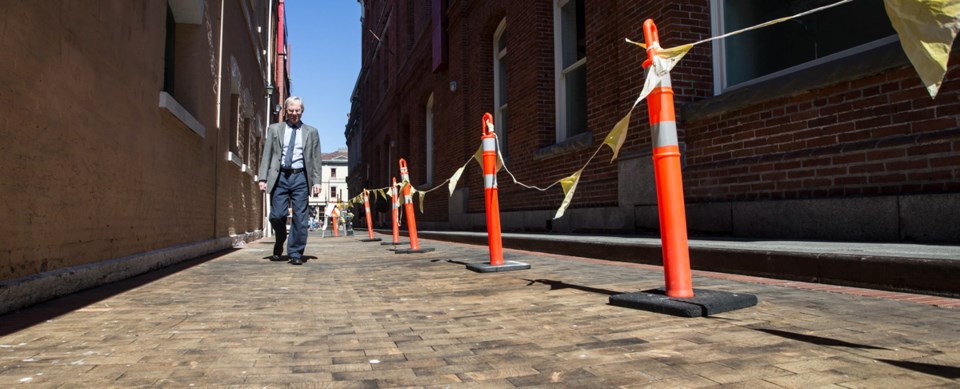As pothole repairs go, this one ranks among the most complicated the city has ever undertaken.
Victoria’s repair of Waddington Alley — the last remaining stretch of city street paved with wooden blocks — involves the use of old-growth Douglas fir taken from the bottom of a lake and has seen months of testing to evaluate the durability of different surface coverings.
“Over the past year, we’ve been testing several different coatings because they [the blocks] can get quite slick in the winter time. There’s not a lot of sun in that alley, so we’ve been testing a couple of things to preserve the blocks and to give a surface that will have some cohesion to it,” said Ed Robertson, assistant director of public works.
In past years, individual wooden blocks or small sections have been replaced as they deteriorated. The work being done this year is more substantial, with about 20 per cent of the blocks to be replaced.
As well, public works wants to resurface the whole alley with a different topping to preserve it and, staff hope, make it less slippery.
Finding the old-growth Douglas fir is not as easy as it was in the early 1900s when the wooden paving blocks were first installed.
“We found a supplier who harvests old-growth timber off the bottom of Lake Cowichan,” Robertson said.
“He’s able to bring that stuff up. It’s in good shape and has some great properties to it, so we thought [we’d] dry it out and then we’d cut it up into blocks to match what’s there.”
To make sure the best finishing material is selected, sections of the new paver blocks cut in the city’s woodworking shop have been banded together in two- or three-foot square groupings, coated with different finishes and then left out to weather at the public works yard. A small section was also fitted into the alley itself.
“We seem to have found one that seems to have stood up the best and has a grip to it,” Robertson said. A lab in Vancouver is evaluating the effectiveness of a non-skid surface.
Robertson said the cost of this year’s work is probably between $20,000 and $30,000.
“We think with the coating we’re about to put down this summer, we think we’re going to get maybe two or three years out of it before we’ll have to redo it. The blocks will still be fine, but we’ll have to re-coat the surface in place,” he said.
“If we can get the right agent into the wood to preserve it and the right non-skid coating, we may get 20 or 25 years out of the blocks.”
The plan is to power-wash and belt-sand the alley prior to applying the coating, beginning next week.
“It will give more of the look of the wood, because when they used to put the tar across, all you would see was the tar. The idea is you want to be able to see the wood,” Robertson said.
The alley, which runs between Yates and Johnson streets, near Wharf Street, was named for Alfred Waddington, who created it to provide access to three lots he owned during the gold rush of 1858.
After Waddington died of smallpox in 1872, the deteriorating state of the alley raised public concerns. Ultimately, the complaints saw the alley paved with creosoted wooden blocks — complete with a metal carriage curb — at a cost of just under $1,000 in 1908. By 1942, it was the only wooden-block stretch of street left in Victoria.
The blocks almost disappeared in the 1980s, when the then-city engineer wanted to rip them up and asphalt the alley.
Coun. Geoff Young, then in his first term in office, remembers walking by and seeing what was about to happen, and then taking the unprecedented step of asking city crews to stop their demolition work.
“I happened to be passing by and saw them ripping up the old blocks. I took it upon myself, quite outside any authority a councillor has, to ask them to stop. I tried to contact the mayor to say this is terrible. They’re ripping up the last of this historic remnant,” Young said.
Council decided in 1992 to preserve and restore the wooden-block alley.
Young recalls that early efforts to replace the blocks soaked in creosote with blocks that hadn’t been treated were less than successful.
“With the new replacement ones, I guess they didn’t want to use all these horrible chemicals that they used in the old days. So I guess they put them in dry and tight. They expanded. They heaved up. They made a big mound a foot high. They had to take them out and fix them somehow,” he said.



